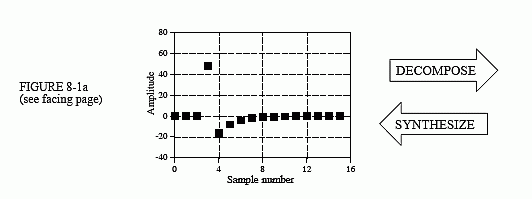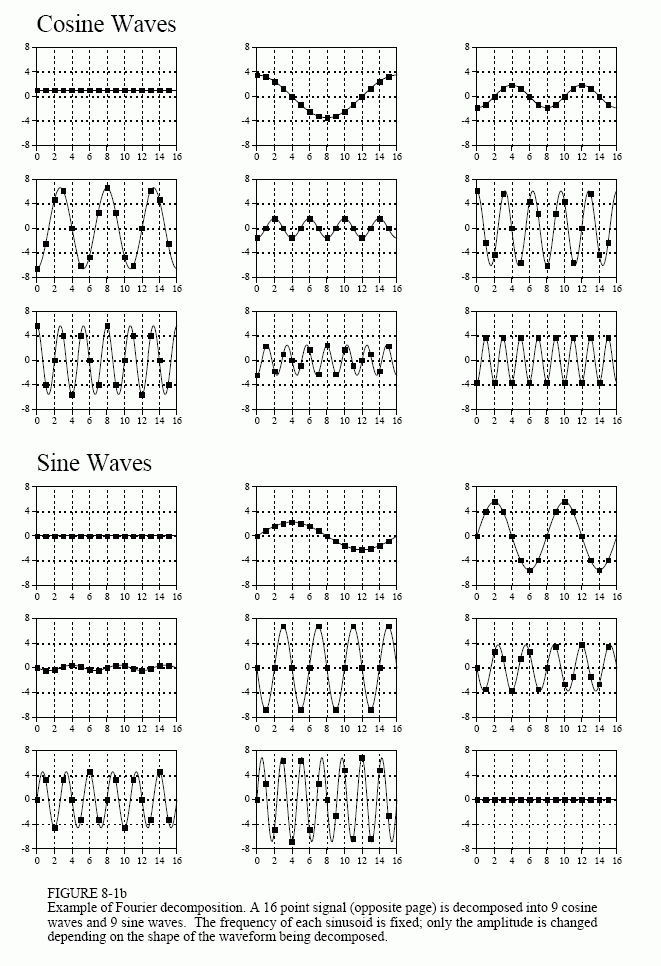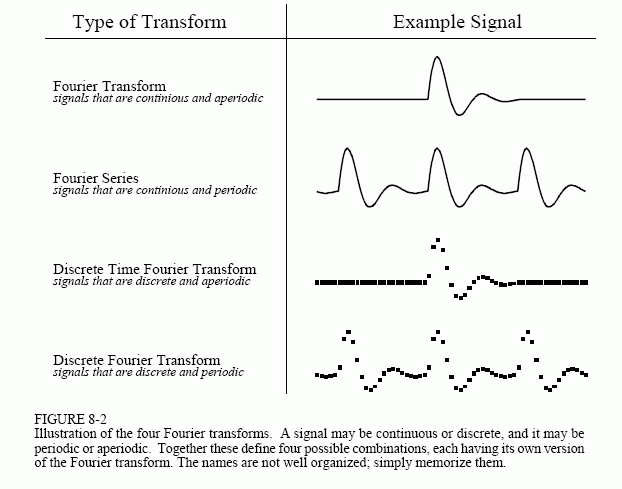The Scientist and Engineer's Guide to
Digital Signal Processing
By Steven W. Smith, Ph.D.
Book Search
Table of contents
- 1: The Breadth and Depth of DSP
- 2: Statistics, Probability and Noise
- 3: ADC and DAC
- 4: DSP Software
- 5: Linear Systems
- 6: Convolution
- 7: Properties of Convolution
- 8: The Discrete Fourier Transform
- 9: Applications of the DFT
- 10: Fourier Transform Properties
- 11: Fourier Transform Pairs
- 12: The Fast Fourier Transform
- 13: Continuous Signal Processing
- 14: Introduction to Digital Filters
- 15: Moving Average Filters
- 16: Windowed-Sinc Filters
- 17: Custom Filters
- 18: FFT Convolution
- 19: Recursive Filters
- 20: Chebyshev Filters
- 21: Filter Comparison
- 22: Audio Processing
- 23: Image Formation & Display
- 24: Linear Image Processing
- 25: Special Imaging Techniques
- 26: Neural Networks (and more!)
- 27: Data Compression
- 28: Digital Signal Processors
- 29: Getting Started with DSPs
- 30: Complex Numbers
- 31: The Complex Fourier Transform
- 32: The Laplace Transform
- 33: The z-Transform
- 34: Explaining Benford's Law
How to order your own hardcover copy
Wouldn't you rather have a bound book instead of 640 loose pages?Your laser printer will thank you!
Order from Amazon.com.
Chapter 8: The Discrete Fourier Transform
Fourier analysis is named after Jean Baptiste Joseph Fourier (1768-1830), a French mathematician and physicist. (Fourier is pronounced: , and is always capitalized). While many contributed to the field, Fourier is honored for his mathematical discoveries and insight into the practical usefulness of the techniques. Fourier was interested in heat propagation, and presented a paper in 1807 to the Institut de France on the use of sinusoids to represent temperature distributions. The paper contained the controversial claim that any continuous periodic signal could be represented as the sum of properly chosen sinusoidal waves. Among the reviewers were two of history's most famous mathematicians, Joseph Louis Lagrange (1736-1813), and Pierre Simon de Laplace (1749-1827).
While Laplace and the other reviewers voted to publish the paper, Lagrange adamantly protested. For nearly 50 years, Lagrange had insisted that such an approach could not be used to represent signals with corners, i.e., discontinuous slopes, such as in square waves. The Institut de France bowed to the prestige of Lagrange, and rejected Fourier's work. It was only after Lagrange died that the paper was finally published, some 15 years later. Luckily, Fourier had other things to keep him busy, political activities, expeditions to Egypt with Napoleon, and trying to avoid the guillotine after the French Revolution (literally!).
Who was right? It's a split decision. Lagrange was correct in his assertion that a summation of sinusoids cannot form a signal with a corner. However, you can get very close. So close that the difference between the two has zero energy. In this sense, Fourier was right, although 18th century science knew little about the concept of energy. This phenomenon now goes by the name: Gibbs Effect, and will be discussed in Chapter 11.
Figure 8-1 illustrates how a signal can be decomposed into sine and cosine waves. Figure (a) shows an example signal, 16 points long, running from sample number 0 to 15. Figure (b) shows the Fourier decomposition of this signal, nine cosine waves and nine sine waves, each with a different frequency and amplitude. Although far from obvious, these 18 sinusoids

add to produce the waveform in (a). It should be noted that the objection made by Lagrange only applies to continuous signals. For discrete signals, this decomposition is mathematically exact. There is no difference between the signal in (a) and the sum of the signals in (b), just as there is no difference between 7 and 3+4.
Why are sinusoids used instead of, for instance, square or triangular waves? Remember, there are an infinite number of ways that a signal can be decomposed. The goal of decomposition is to end up with something easier to deal with than the original signal. For example, impulse decomposition allows signals to be examined one point at a time, leading to the powerful technique of convolution. The component sine and cosine waves are simpler than the original signal because they have a property that the original signal does not have: sinusoidal fidelity. As discussed in Chapter 5, a sinusoid input to a system is guaranteed to produce a sinusoidal output. Only the amplitude and phase of the signal can change; the frequency and wave shape must remain the same. Sinusoids are the only waveform that have this useful property. While square and triangular decompositions are possible, there is no general reason for them to be useful.
The general term: Fourier transform, can be broken into four categories, resulting from the four basic types of signals that can be encountered.

A signal can be either continuous or discrete, and it can be either periodic or aperiodic. The combination of these two features generates the four categories, described below and illustrated in Fig. 8-2.
Aperiodic-Continuous
This includes, for example, decaying exponentials and the Gaussian curve. These signals extend to both positive and negative infinity without repeating in a periodic pattern. The Fourier Transform for this type of signal is simply called the Fourier Transform.
Periodic-Continuous
Here the examples include: sine waves, square waves, and any waveform that repeats itself in a regular pattern from negative to positive infinity. This version of the Fourier transform is called the Fourier Series.
Aperiodic-Discrete
These signals are only defined at discrete points between positive and negative infinity, and do not repeat themselves in a periodic fashion. This type of Fourier transform is called the Discrete Time Fourier Transform.
Periodic-Discrete
These are discrete signals that repeat themselves in a periodic fashion from negative to positive infinity. This class of Fourier Transform is sometimes called the Discrete Fourier Series, but is most often called the Discrete Fourier Transform.
You might be thinking that the names given to these four types of Fourier transforms are confusing and poorly organized. You're right, the names have evolved rather haphazardly over 200 years. There is nothing you can do but memorize them and move on.
These four classes of signals all extend to positive and negative infinity. Hold on, you say! What if you only have a finite number of samples stored in your computer, say a signal formed from 1024 points. Isn't there a version of the Fourier Transform that uses finite length signals? No, there isn't. Sine and cosine waves are defined as extending from negative infinity to positive infinity. You cannot use a group of infinitely long signals to synthesize something finite in length. The way around this dilemma is to make the finite data look like an infinite length signal. This is done by imagining that the signal has an infinite number of samples on the left and right of the actual points. If all these imaginary samples have a value of zero, the signal looks discrete and aperiodic, and the Discrete Time Fourier Transform applies. As an alternative, the imaginary samples can be a duplication of the actual 1024 points. In this case, the signal looks discrete and periodic, with a period of 1024 samples. This calls for the Discrete Fourier Transform to be used.
As it turns out, an infinite number of sinusoids are required to synthesize a signal that is aperiodic. This makes it impossible to calculate the Discrete Time Fourier Transform in a computer algorithm. By elimination, the only

type of Fourier transform that can be used in DSP is the DFT. In other words, digital computers can only work with information that is discrete and finite in length. When you struggle with theoretical issues, grapple with homework problems, and ponder mathematical mysteries, you may find yourself using the first three members of the Fourier transform family. When you sit down to your computer, you will only use the DFT. We will briefly look at these other Fourier transforms in future chapters. For now, concentrate on understanding the Discrete Fourier Transform.
Look back at the example DFT decomposition in Fig. 8-1. On the face of it, it appears to be a 16 point signal being decomposed into 18 sinusoids, each consisting of 16 points. In more formal terms, the 16 point signal, shown in (a), must be viewed as a single period of an infinitely long periodic signal. Likewise, each of the 18 sinusoids, shown in (b), represents a 16 point segment from an infinitely long sinusoid. Does it really matter if we view this as a 16 point signal being synthesized from 16 point sinusoids, or as an infinitely long periodic signal being synthesized from infinitely long sinusoids? The answer is: usually no, but sometimes, yes. In upcoming chapters we will encounter properties of the DFT that seem baffling if the signals are viewed as finite, but become obvious when the periodic nature is considered. The key point to understand is that this periodicity is invoked in order to use a mathematical tool, i.e., the DFT. It is usually meaningless in terms of where the signal originated or how it was acquired.
Each of the four Fourier Transforms can be subdivided into real and complex versions. The real version is the simplest, using ordinary numbers and algebra for the synthesis and decomposition. For instance, Fig. 8-1 is an example of the real DFT. The complex versions of the four Fourier transforms are immensely more complicated, requiring the use of complex numbers. These are numbers such as: 3 + 4j, where j is equal to √-1 (electrical engineers use the variable j, while mathematicians use the variable, i). Complex mathematics can quickly become overwhelming, even to those that specialize in DSP. In fact, a primary goal of this book is to present the fundamentals of DSP without the use of complex math, allowing the material to be understood by a wider range of scientists and engineers. The complex Fourier transforms are the realm of those that specialize in DSP, and are willing to sink to their necks in the swamp of mathematics. If you are so inclined, Chapters 28-31 will take you there.
The mathematical term: transform, is extensively used in Digital Signal Processing, such as: Fourier transform, Laplace transform, Z transform, Hilbert transform, Discrete Cosine transform, etc. Just what is a transform? To answer this question, remember what a function is. A function is an algorithm or procedure that changes one value into another value. For example, y = 2x + 1 is a function. You pick some value for x, plug it into the equation, and out pops a value for y. Functions can also change several values into a single value, such as: y = 2a + 3b + 4c, where a, b and c are changed into y.
Transforms are a direct extension of this, allowing both the input and output to have multiple values. Suppose you have a signal composed of 100 samples. If you devise some equation, algorithm, or procedure for changing these 100 samples into another 100 samples, you have yourself a transform. If you think it is useful enough, you have the perfect right to attach your last name to it and expound its merits to your colleagues. (This works best if you are an eminent 18th century French mathematician). Transforms are not limited to any specific type or number of data. For example, you might have 100 samples of discrete data for the input and 200 samples of discrete data for the output. Likewise, you might have a continuous signal for the input and a continuous signal for the output. Mixed signals are also allowed, discrete in and continuous out, and vice versa. In short, a transform is any fixed procedure that changes one chunk of data into another chunk of data. Let's see how this applies to the topic at hand: the Discrete Fourier transform.
